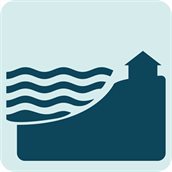Tailored assessment of coastal and fluvial floods
The tailored assessment supports a comprehensive risk analysis (see Risk assessment guidance) by calculating total damages across various events with different probabilities, resulting in an expected annualised damage, commonly referred to as risk. For conducting a tailored assessment, external expertise may be required to achieve a robust analysis.
A 2015 study shows that most flood risk assessment frameworks generally follow a similar approach. They typically begin with an assessment of flood hazards, which indicates the probability and intensity of potential events. Hazard information can then be overlaid with a portfolio of assets to determine what is exposed to flooding. Combining exposure data with vulnerability information, such as asset-specific damage curves, allows for estimating potential damage. By calculating total damages across various events with differing probabilities, an expected annual damage can be determined.
To support a tailored assessment, this website refers to the publicly available software National Damage and Fatality Model (SSM2023). SSM2023 can be used to calculate damage based on the results of a flood simulation. The software, documentation, and user manual can be downloaded for free through the Living Environment Information Point website.
SSM2023 allows for the calculation of various flood impacts for each simulation of a Dutch flood, such as estimating direct damage and potential casualties. Physical damage is determined by aggregating the loss of capital and production per affected object or land use. The relationships between damages and flood characteristics are defined for each damage category in damage functions (or vulnerability curves). Direct damage encompasses the harm caused to objects, capital goods, and movable property due to direct contact with water. It also encompasses business interruption losses, which are damages resulting from business disruptions and production downtime.
SSM2023 includes depth-damage functions for various categories, including businesses, residences, infrastructure, and other categories such as agriculture and horticulture. Each category has a maximum damage amount. These maximum damage amounts are determined based on Statistics Netherlands (CBS) macro data per sector at the national level.
To be able to calculate the expected damage with SSM2023, at least one map must be provided with the flood depth per location. For this purpose, the specific flooding scenarios that were displayed by the tool My Water Risk Profile as part of the basic assessment can be used or the individual flood scenario events from the detailed assessment. The Water Risk Profile contains references to underlying, specific flood scenarios in the National Water and Flood Information System (LIWO).
It should be noted that SSM2023 has been designed (and is appropriate) for especially large-scale floods and does not include specific building properties and therefore is not always accurate to assess the level of expected damage for individual assets. However, the model can potentially be modified with custom damage functions to get a better estimate of damage for more local assessment. An example are the damage functions made by a 2023 publication, based on the Limburg flooding of 2021.
For more information about SSM2023, we refer to the Living Environment Information Point.

